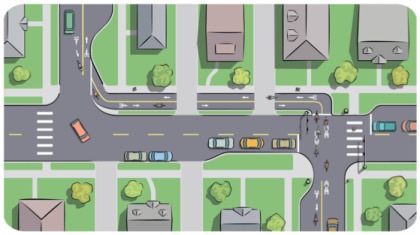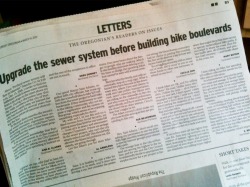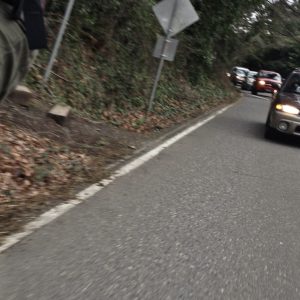
(Photo: PBOT)
Today, Mayor Sam Adams and his colleagues on City Council will vote on whether or not to allow $20 million from the Bureau of Environmental Services budget to be funneled into the City’s Green Streets program and be specifically tagged for use on bike boulevard projects.
The money would bolster a program that has been a part of the City’s planning goals since 2004 and it would be a shot in the arm to the Bureau of Transportation’s efforts to create a citywide network of safe streets. The proposal is expected to pass, but the road to the vote has been anything but speed-bump free.

(Graphic: PBOT)
At the core of Adams’ idea is a plan to use $15 million, out of a total of over $40 million, which has been saved by BES due to projects that have come in under budget over the past two years. In a statement released yesterday, Adams said, “These significant savings mean the City can make these Green Streets investments without impacting rate payers or Council-approved Capital Investment Plans.”
Despite these assurances from the Mayor, using money from a bureau that ostensibly provides “environmental services,” and is the home bureau of our sewer system, to pay for projects that will make biking more pleasant has been a bit of a logical leap for some.
The local media have likened this to a “swap” from sewers to bike lanes, and not surprisingly, the sentiment of many Portlanders has not been positive.

March 14th. All seven letters were against
Adams’ idea.
Much of the early criticisms of the plan stemmed from a memo written by BES (not Mayor Adams or PBOT staff) about where the $20 million would come from. A big chunk of the money, BES wrote, would come directly from sewer projects.
When Adams released his plan of where the money would come from — making it clear that it would not impact rate payers or projects — some were still skeptical.
Even commenters here on BikePortland are wary. When I reported on details of Adams’ plan on March 9th, commenter Gil Johnson wrote:
“As a home owner, landlord and daily bike commuter, I definitely have mixed feelings about the diversion of sewer fees to bicycle projects. It may be a small victory for biking in the short run but result in a nasty backlash that scuttles the bike plan in the future.”
According to an analysis by BES, the impact of not spending $15 million on capital projects would cut next year’s expected sewer bill increase by 0.15% (from 6.99% to 6.84%). Based on that calculation, the Office of Management and Finance estimates the savings to ratepayers would be about 7 cents per month.
Portland Mercury news editor Matt Davis, who gets around town on a bike and who has always been supportive of bike-related policies, didn’t mince his words when he wrote a story with the headline, I’m Uncomfortable With Bikes Plan Kickstart.
The same day, Anna Griffin, a sensible and respected columnist for The Oregonian, likened Adams’ actions around this proposal as “on the fly budgeting” that “doesn’t serve taxpayer interests.” Griffin criticized Adams not for the merits of his idea, but rather his approach to seeing it through. She wrote that, instead of the usual process involved with these types of proposals, Adams’ actions are illustrative of what happens when city leaders, “chuck the process, declare an emergency and do whatever they want.”
I share some of Griffin and Davis’ discomfort with all this.
While I think the idea is solid (read why below), it’s a shame that the PR around it has been so mishandled. Once again, some people feel that Mayor Adams is pushing a hastily formed idea on them at the last minute just to appease the “bike community.” This isn’t good for Adams or for people that care about bikes and it’s reminiscent of his handling of the Sauvie Island/Flanders Street Bridge proposal.
That idea was nowhere near as solid as this one, but it also seemed rushed, it was heavily criticized, and it raised anti-bike sentiment in the City. Like the proposal they’re voting on today, the Flanders Bridge project was put to vote as an “emergency” ordinance, and, despite the project’s merits, it turned into a PR debacle that was ultimately shelved by Adams at the last minute.
Hopefully, this proposal won’t see the same fate. Despite what all the letters to the editor and headlines say, there is a clear connection between sewer pipes, stormwater runoff, green streets and bike boulevards. And it’s not just Adams and bike and environmental advocates who see the connection. The City of Portland has officially embraced the concept since 2004.
The City adopted its Stormwater Management Plan in 2004. That plan required green street features on many public works projects and it identified the connection between infrastructure that meets environmental and transportation benefits.
Three years later, the City adopted their Green Street policy, which solidified the role of transportation infrastructure projects in reducing the stormwater runoff. It directed City staff to “Seek opportunities to leverage the work and associated funding of projects in the same geographic areas across Bureaus to create Green Street opportunities.” And for all the detractors who see this as some sort of hare-brained idea, Green Streets are officially defined in that document as streets that meet, “Broader community goals by providing pedestrian and where appropriate bicycle access.”
Integrating stormwater treatment into bike boulevard features is also referenced several times in the City’s 2030 Bike Plan, which passed City Council by a unanimous vote just last month.
Some have also argued that the $15.4 million in BES “contract savings” that Adams wants to direct into bike boulevard treatments should go back into ratepayer’s pockets. Commissioner Fritz asked Mayor Adams to clarify this at the Council meeting last week.
According to an analysis by BES, the impact of not spending $15 million on capital projects would cut next year’s expected sewer bill increase by 0.15% (from 6.99% to 6.84%). Based on that calculation, the Office of Management and Finance estimates the savings to ratepayers would be about 7 cents per month.
If this idea of re-greening our streets and simultaneously making them safer and more accessible for everyone is fully embraced (and judging from the internal politics going on between Mayor Adams and BES, that remains to be seen), it could have a transformative effect on our city.
Stay tuned for updates on today’s vote from City Hall.







Thanks for reading.
BikePortland has served this community with independent community journalism since 2005. We rely on subscriptions from readers like you to survive. Your financial support is vital in keeping this valuable resource alive and well.
Please subscribe today to strengthen and expand our work.
That whole funding thing is sticky and I’m not yet sure which side to take.
My comment is more about the conceptual drawing of the green street/bike boulevard. I had always pictured one direction of cyclists on one side of the street and the other on the other side. Does the scheme above look like it could be simplified to anyone besides me? It shows almost an entirely new and separate street which could confuse both cyclists and drivers. Not sure who did the drawing, but I was expecting more integration I guess……
About 99% of the various blogs have all been against this. Like a true dictators they will go ahead and do what they want regardless of their constituants wishes.
Stupid move for anybody in politics.
Nick – the drawing you refer to is for a solution to a problem like NE Going St at 33rd Ave. The intersection is offset, meaning newbie bikers have to turn left and brave a busy avenue’s traffic for about a half block. For a lycra biker, no big deal. For a family with trailer or youngster on their own bike, more like a deal-breaker for that ride.
I used to live on Going and this was definitely my least favorite part of the route – even with 30+ years of city biking experience.
This is an unusual treatment as far as bike boulevards go, but a good solution for a situation that is fairly common in Portland. To “simplify” it, as you suggest, the City would probably have to install two traffic signals – which run about $250,000 – 300,000 each.
curb extensions suck, they are a hazard to cyclists and not a benefit, green or otherwise
my objections to the proposed treatment at northeast going and 33rd include but are not limited to the following:
(a) obviously it would be absurd to require me to veer across 33rd to pick up the cycletrack if i am heading north on 33rd from farther south;
(b) even if i am turning left onto 33rd from going heading north, if I am not planning to continue east on going there is no point in my getting onto the cycletrack and getting hung up in the box when I could simply take the lane;
(c) there will be all kinds of confusion in and around the box;
(d) motor vehicles parked along the west edge of the road north of the crossing
will block my view of southbound traffic;
(e) etc., etc.
must, must, must repeal mandatory sidepath law.
The idea of achieving storm water runoff/’green street’ objectives and pedestrian/bike street usability is worthy enough. Unfortunately, Adams and Portland City Council have not adequately introduced the idea to the public whose money they want to use to put the idea into action.
I’m also not impressed with curb extensions. But here’s one condition on which I might take a more favorable view of them: have motor vehicles switch places on the street with bike traffic…bikes taking the center…cars furthest to the right as possible, allowing them to deal with the curb extensions.
Just my dumbass opinion, but if we called Bike Boulevards something different we might have a better public relations situation.
BB benefit pedestrians, bicyclists and the homeowners on the streets ($$ in home value). Perhaps if they were called, I don’t know, “low-speed boulevards” or “low-car diet streets” and didn’t have the name “bike” in them, they wouldn’t bring up the knee jerk reactions.
Had the bike boulevard been called something different, Sam could have said that the $20M was creating a “low-car diet” street while simultaneously:
• supporting the Green Streets initiative with the bio-swales,
• creating neighborhood improvements across the city,
• relieving strain on the storm water system,
• AND fitting within the 2030 bike plan.
@John Lascurettes #7:
Not a dumbass opinion at all, in my own opinion, and, in fact an excellent idea. The word “bike” DOES get a negative knee-jerk reaction from a lot of people, and repeating it over and over isn’t going to change their minds.
The fact is, as you say, “bike boulevards” are way more than that. It’s an inaccurate name and a limiting one.
“Low-car diet” isn’t gonna go over any better (worse, perhaps), but I think you might be on the right track with “low speed boulevards”.
Seriously, City Hall and PBOT need to consider something like this. They are in big PR trouble right now with bikes.